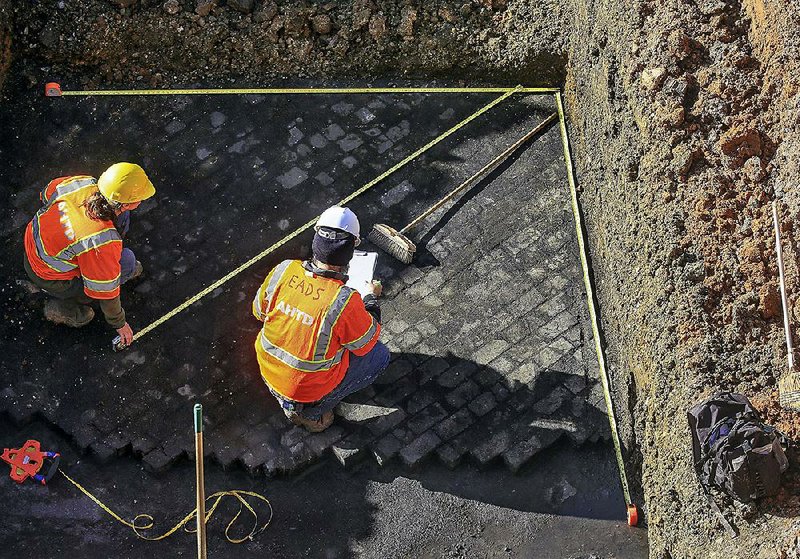Construction on the new Broadway Bridge has uncovered remnants of an almost forgotten pavement technology -- wooden blocks -- that the old Broadway Bridge had buried.
The wooden-block pavement appears to date from the turn of the 20th century before the old bridge was built in 1922, according to state archaeologists who spent part of Thursday reviewing the artifacts. Workers uncovered the pavement last week on the Little Rock side of the bridge, they said.
Wooden-block pavement became common for city streets in the United States beginning in the mid-19th century as an alternative to cobblestones to reduce noise when traffic primarily was horses and wagons.
The wooden-block pavement is in the block of Broadway between West Markham Street and the new bridge and its southern approach, both of which are under construction.
For now, the Arkansas Highway and Transportation Department is withholding comment, which spokesman Danny Straessle said is "standard protocol so that [the archaeologists] can catalog [the site] and figure out what we've got there."
The discovery comes as the $98.4 million construction project reaches its midway point. The contractor has 180 days in which to remove the old bridge and open the new one to traffic. The official halfway mark -- 90 days -- was at midnight Thursday.
Straessle said Highway Department officials don't expect the archaeological find to delay the bridge project.
Archaeologists at the site Thursday said it was likely that the old, now-demolished bridge was built over what appears to be wooden-block pavement that once covered Broadway. The evidence of that is now at the bottom of a large hole.
According to an essay on the history of wood as a paving material, the technology was popular for limited applications.
"Wood-blocks were not intended as an all-purpose paving material but a special substance for selected streets," David O. Whitten, an economics professor at Auburn University wrote in the essay titled: "A Century of Parquet Pavements: Wood as Paving Material in the United States and Abroad, 1840-1940," published in Essays in Economic History in 1998.
"City engineers did not envision a city paved with wood. They did consider wood blocks appealing for streets near hospitals, schools, churches, and public buildings like court houses where street noise was especially bothersome and in congested streets with heavy traffic."
Broadway extends past the Pulaski County Courthouse, which was built in 1887-89. Another section was added to the courthouse in 1913-14.
Pouring asphalt and concrete weren't options in the late 19th and early 20th centuries, and rather than dirt for city streets, engineers initially turned to bricks and other blocks to address the streets' dust and mud.
"Heavily travelled routes required thick granite blocks, heavy bricks, or squares of iron or steel," Whitten wrote. "Lightly used residential streets were paved with thin granite, light bricks, or blocks of asphalt, concrete, iron, or steel."
But on busier thoroughfares, wooden blocks provided a "fetching" alternative, he said.
"It is not easy for modern men and women to imagine the noise generated by hundreds of steel-tired wagon wheels and horse shoes on bricks, steel iron, or granite block streets sandwiched between multileveled buildings," Whitten wrote. "A wooden pavement was no small blessing in the horse and wagon society.
"Wood blocks were also useful in filling gaps around trolley tracks. The flexible wood was less likely to crack, break, or wander from the vibrating iron or steel rails."
Whitten's research included an article titled "Wood-Block Paving in Little Rock, Arkansas," which appeared in a publication called American City in 1920.
But needs changed, and wooden blocks became obsolete.
"Wood-block paving was not a whimsy but solution to a serious urban problem," Whitten wrote. "Wooden streets, like trolleys, are no more because technology offered new alternatives in transportation that eliminated the need for them."
Information for this article was contributed by Benjamin Krain of the Arkansas Democrat-Gazette and by Emma Pettit of Arkansas Online.
A Section on 12/30/2016


